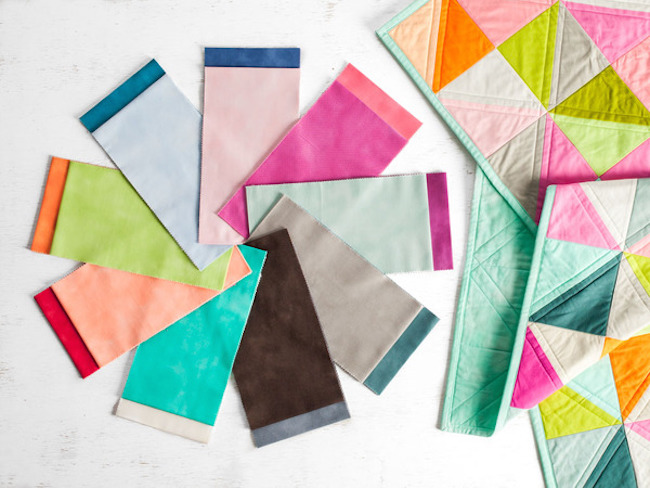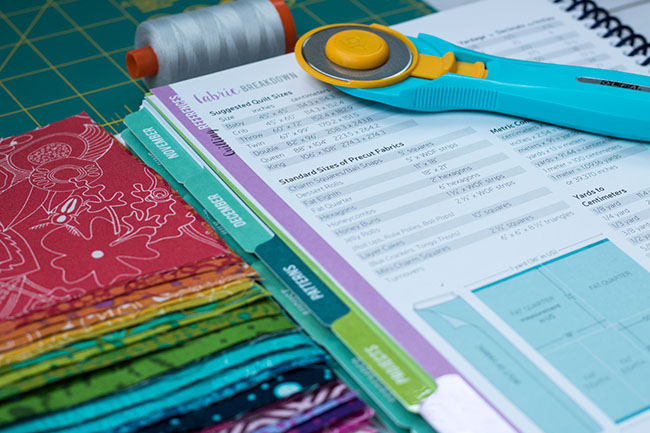Pre-cut fabrics (like jelly rolls, fat quarters and charm packs) can make your quilting life so much easier. But sometimes pre-cuts may have problems, and it’s helpful to know some troubleshooting tips and tricks when working with them.

Hometown Call Me Contemporary Quilt Kit
The problem: Pinked edges
Some pre-cuts like charm squares, layer cakes, and mini charms, are pinked (zig zagged) to keep the fabric from unraveling. You’re not sure how to deal with pinked edges to get an accurate ¼” seam.
The solution
Don’t cut off those pinked edges! Just measure from the outer points of the pinked edges as if they are the straight edge of the fabric, and then trim to the desired size if needed.
When aligning your fabrics for sewing, use those outer points of the pinked edges as the edge of the fabric so that your ¼″ seam allowances will be accurate.
The problem: Crooked cuts
The pre-cut is crooked (not a true square or rectangle) or not true to size.
The solution
If you get home and discover that your newly purchased pre-cuts aren’t true to size, first, don’t be afraid to let the seller know about your problem. They will most likely thank you for identifying a manufacturing-based problem that may affect other customers; and, you may be able to return them.
If you can’t return them, the best option is to save that stack of pre-cuts for a pattern that requires a smaller piece. For example, if your layer cake squares measure 9¾” instead of a true 10″, choose a pattern that requires that layer cake to be trimmed down a bit. The pre-cuts still will make your life easier than working with yardage, even if you end up making a few extra cuts.
The problem: Off-grain cuts
The pre-cut is cut off-grain, and you end up with stretchy fabric and can’t match your points as easily.
It can be hard to tell whether your pre-cut is on grain or not, and most likely, this type of imperfection will only be noticeable to advanced quilters or show quilters. In fact, to begin with, many prints are not even printed on grain.
Here’s the gist of the problem, if you’re curious: When your fabric is not cut on grain (meaning it’s cut on the bias), that means the fabric will stretch, which could lead to fullness in some areas of your quilt top. This, in turn, can make it difficult to quilt (pleats and folds in your quilting). Fabric that is cut off-grain can also stretch, making it difficult to easily match your points.
The solution
Starch your fabric! A little starch, like the kind you buy in the grocery store, can go a long way to fix stretchy fabric. This is a quick an easy fix that anyone can accomplish.
Also, don’t be afraid to just save those off-grain pre-cuts for a pattern that does not require that you match points.

More quick tips for working with pre-cuts
- When you shop, bring a mini tape measure with you. Measure the pre-cuts to make sure they’re true to size before you buy.
- Don’t wash pre-cuts. If you do, they will fray and unravel and may shrink inconsistently.
- Measure your pre-cut pieces before you start stitching.
- If you have a problem with an excessively fraying jelly roll, use it for a scrappy binding instead of the body of the quilt.
- To make your life easier when cutting, stack up to six pieces of fabric at a time, and use a brand new 60 mm rotary cutter (instead of a 45 mm rotary), so you can cut the thicker stack more quickly.
- If you sometimes forget all the common pre-cut sizes and names, or need help keeping all your pre-cut projects organized, check out The Quilter’s Planner. It has calendars, project planning pages, and a full reference section that lists information (like all the types of pre-cuts you’ll find in the quilting world). It also comes with 14 patterns in a magazine, many of which are pre-cut friendly!
The truth is, if you’re making a quilt to cuddle or gift, most minor problems with pre-cuts will not be noticeable. Sure, if you’re making a show quilt, your points need to be perfectly matched, and any imperfection may be noticed (and judged). But the vast majority of us can sit back and enjoy the fact that some very clever person discovered a way to make fabric a lot easier and more fun for the average quilter to work with each day.

This article has answered many questions I’ve had about the inconsistencies in pre-cuts. Thanks!
Great info, especially sewing Pinked Edges, now I know , to get the 1/4" seam measure from peak of pinked edge.
This is so helpful. Knowing what to do with precuts that aren't exactly cut right will save me a lot of money because I throw them away. Knowing what else can be done is certainly a great way to repurpose.